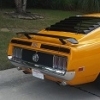Leaderboard
Popular Content
Showing content with the highest reputation on 04/12/2022 in Posts
-
2 points

Help Me Diagnose FMX Vibration
Grabber70Mach and one other reacted to copb8 for a post in a topic
FINALLY! After jack with it for just over 2 YEARS I have a smooth running transmission. And like I had been saying over and over again, it was the torque converter. They finally pulled the trans again and rebuilt the converter. Now it runs as smoothly as it did when I first brought it in to fix it shifting and leaking. It'll be nice to go down the road and not be pissed off every time I get above 2150 RPMs. -
1 point

Kill Switches and how to Protect your Car
KMD88 reacted to Mach1 Driver for a post in a topic
Kill Switches and Protecting your Car It seems that everyone has their own opinion or philosophy about protecting their car…and you know what they say about opinions, but here is mine. Some people only insure their car and don’t even lock it, insisting that an accomplished thief will steal it if they want it. To me, that says they have no personal investment in the car- no blood, sweat, or pride of ownership. Mine is part of the family, a very old friend, and it’s MY CAR, not theirs for the taking. So here are the steps I have taken. I believe you must have a layered approach, with as many layers as you can apply. Slow the thieves down and make it as difficult as possible. In this case, I believe that paranoia can be your friend. 1. Insurance: today's thieves could roll up with a car hauler and a GPS jammer. Unless you have your Mark 1000 Visual Acuity Devices trained on it (your eyeballs), your car will be gone. But most thieves aren’t that accomplished or prepared, and don’t need to be- it’s just too easy to steal a classic Mustang. So insure it and keep it in sight as much as possible when it is out of your garage. 2. Where you take it: don’t take it to the mall, theatre, supermarket, or other long term parking place. They only need seconds. When on a road trip, one of our members will take his car to the local police department and ask them to lock it in their secured parking overnight. He claims he has never been turned away as long as he offered them a ride. 3. Lock the hood: everything they need to steal the car is under the hood, so protect it. There is way too much mischief they can get into under there. I use a 76 Ford F350 truck hood latch. It has a cable going inside to a handle with a keyed lock. You also need a “helper spring” mounted to the hood. This pushes the hood up and away from the latch so the latch doesn’t re-engage as soon as you release the pull handle. Mid 70s Ford truck latches will bolt right into a 69-70 Mustang and the same vehicle also has the helper spring. All I had to modify was the secondary safety release arm so it was easier to access. 4. Lock the doors: this is so obvious that I almost didn’t mention it. If you don’t give them an open invitation, they may move on. It’s just basic common sense. 5. Alarm: a noise maker is good- I like them. Even if other people don’t pay attention, you will. They can have vibration, and glass sensors, door, hood and trunk switches (remember to lock the hood anyway), and they can even call you if they sense an alarm or set off a GPS tracker. It’s all good stuff and part of the layering process. Where they fall short is how they attempt to actually prevent the car from running, and that will require a technical discussion on KILL SWITCHES. On the other hand, a system like LoJack is good (and expensive), but it doesn’t try to stop the theft, it just shows the cops where it is once you notify them it has been taken. 6. How cars are stolen: the method most often used is a jumper wire and a screwdriver. This is so ridiculously easy that you won’t believe it, and it literally only requires seconds. Here’s what they do: (1) Lift the hood (that’s why you have to lock it). (2) Put a jumper wire from the battery positive to the coil positive. This supplies power directly to your ignition system, and bypasses everything, including aftermarket alarms. (3) Use a screwdriver to short from the front solenoid terminal to the “S” terminal. This cranks the engine to start it, and they are gone. Seeing is believing, so here is a link to an 8-1/2 minute video, where he shows how to jack a 60s era car. It’s not a Mustang, but it has the SAME features. If anything, a Mustang is easier to steal because the coil and solenoid are up front. If you pay attention around 4:15, he talks about Fords. He’s a little long winded, but I find him entertaining, and everything he says is unfortunately accurate. As you’ll see, it takes him about 58 seconds to open the locked door, then the hood, start the engine and close the hood- all while explaining it and not rushing the process. PLEASE WATCH THIS Below is a schematic (not a wire diagram) that shows why this is so simple and how it works. This is the ignition system for a classic Mustang: The jumper wire is #2, which connects the battery directly to the coil and bypasses everything else (ignition switch, alarm, whatever). The screwdriver is #3, which connects the battery to the solenoid “S” or coil terminal. This turns the solenoid on and the engine cranks for as long as the screwdriver is there. And away they go. 7. KILL SWITCHES: this is a kill switch used on a car with points. It is just a simple on-off toggle switch with one side connected to the chassis and the other side connected to the wire going between the coil and the points. Don’t let this description throw you – this is just how the physical laws in our little corner of the universe work: The points have to open and close to make the magnetic field of the coil build and collapse to make a high voltage spark. With the kill switch closed the coil will stay on, but the field can’t collapse, so there is no transformer action in this DC circuit, so there is NO spark. 8. Kill Switches for other ignition systems: here are a few other popular ignition systems and how to disable them. This would work for a Pertronix 1 as well. When I showed the example in #6 above to Pertronix, they were sure it would disable the car, but thought it may also damage the Pertronix module. They offered this solution instead: ANOTHER... 9. Fuel kill switches: there’s no magic here, just a switch to open the circuit to a pump or fuel solenoid. 10. The Problem with Kill Switches is simple- where to hide the switch? If it could be hidden in a place where it’s not seen or found, but can still be activated, then that would make it very difficult to defeat. That can be done using a magnetic reed switch. The reed can be hidden behind the plastic of the dash or console, or “A” pillar trims, or behind any plastic. Then when you pass a magnet over it (within about an inch) it will allow the car to start. In this simple circuit, the kill switch is turned on as soon as the ignition key is turned off. So you can’t forget to set the kill switch (its automatic), you just have to use the magnet to turn the kill switch off, so you can start the car. So, turn the key to ON, pass the magnet near the reed switch and the LED will turn ON, announcing the kill switch is OFF, then turn the key to start. Easy peasy. For maintenance by some shop, insert a fuse (safer than using a switch) and the kill switch is bypassed. Side note...you may think this is a bit too complicated and unnecessary, but after reading all of the above, one guy told me that he uses RFID (radio frequency identification) to "unlock" his limit switch. I think that's really cool, but WOW! That's a whole lot more complicated than a reed switch, a magnet and a relay. 11. Transmission lock: If you have a 70, I understand this was done from the factory. If the back wheels can’t roll, it makes the process of towing more difficult. I have a 69 with an automatic and of course it has a floor shifter (since that’s all they ever came with). Back in the day, and long before digital pictures, I came up with a method to lock the shift linkage with a spring loaded pin. The pin is removed from the linkage by a solenoid, and it is operated by a switch that is controlled by the shift button on the T-handle. If the kill switch is on, the power to the solenoid is cut and you can’t take it out of park. I would love to show it to you, but I still don’t have any pictures. I came up with this using the simple home tools I had at the time, so think about it and surprise us with your version. You may be able to provide pictures before I tear mine apart ;) 12. Electronic handbrakes: sometimes called electronic parking brakes – work on the same basis but use electric motors to achieve the locking effect. Press or pull the button and motors on the rear brakes press the pads onto the discs. You can often hear a reassuring whirring noise as the motors do their work. -
1 point

1969 Repro Headlight Harness May be Incorrect
69RavenConv reacted to Midlife for a post in a topic
A customer sent in a 69 non-tach headlight harness for refurbishment, but it was too far gone for me to repair. The main power lines to/from the starter solenoid and alternator didn't look right to me, as the alternator line should go down into the harness quite a ways, and then gets spliced back into the main power feed. This is the point where one of the ammeter lines gets its signal (yellow wire). Instead, the yellow wire only was spliced into the main power feed, and the alternator line looped back and was spliced into the main power feed before going to the starter solenoid. Whoever designed this created an epic failure of the ammeter, which now can only read discharge and never any charging. (Not that they were all that functional anyway, but still...) I do not know if this was an AMP harness or someone else who fabricated 69 headlight harnesses. The next time I get a true AMP harness in, I'll tear it apart and see if they have this bad design or not.
